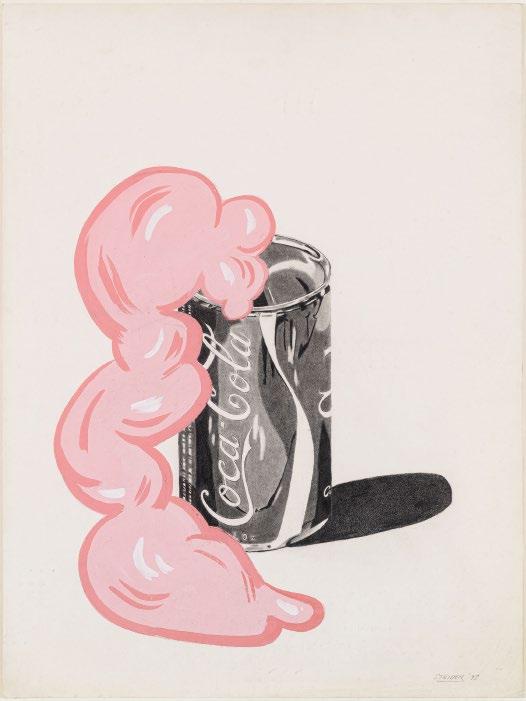
2 minute read
Draw Like a Machine: Pop Art, 1952–1975
October 29, 2021–March 13, 2022
Draw Like a Machine: Pop Art, 1952–1975 featured more than thirty drawings primarily sourced from the Menil Collection’s permanent holdings, along with select loans from local Houston collections.
Advertisement
Draw Like a Machine focused on works made during a time when gestural and expressionistic mark-making was considered increasingly outmoded, and artists were actively experimenting with images and processes borrowed from advertising and mass media. The drawings included in this exhibition bridged the seeming contradiction between the manual and the mechanical.
Highlights of the exhibition included Andy Warhol’s series of six drawings of critic Gene Swenson completed in 1962, the year before Swenson’s iconic ARTnews interview with Warhol, which centered on the broad inquiry, “What is Pop Art?” In response to the question, Warhol declared his intention to “be a machine” and “machine-like” in his art practice, a quote that inspired the exhibition’s title. Warhol used a blotted line technique that combined drawing and printmaking strategies to create works that intentionally resembled printed reproductions. The exhibition also included several other of Warhol’s drawings from the 1950s, highlighting the range of techniques he employed.
The exhibition also spotlighted a generation of American artists in the United States who bridged fine art and industrial design, including Roy Lichtenstein, James Rosenquist, and Idelle Weber. Certain works, for example, by Marjorie Strider and Tom Wesselmann, foregrounded the alluring visual advertising strategies developed by postwar marketing firms to direct and encourage consumer spending. Californian artists such as Ed Kienholz blurred the lines of art and commerce even further.
Draw Like a Machine: Pop Art, 1952–1975 was curated by Kelly Montana, Assistant Curator, Menil Drawing Institute.
This exhibition was generously supported by Angela and William Cannady; Catherine Miller in memory of Marcy Taub Wessel; Indigo Natural Resources; Ann and Mathew Wolf Drawing Exhibition Fund; Clare Casademont and Michael Metz; John R. Eckel, Jr. Foundation; Linda and George Kelly; Susanne and William E. Pritchard III; Leslie and Shannon Sasser; and the City of Houston through Houston Arts Alliance.
Spatial Awareness: Drawings from the Permanent Collection
October 29, 2021–March 13, 2022
Spatial Awareness: Drawings from the Permanent Collection brought together a diverse group of thirty drawings from the mid-20th century to the present day that illustrate how artists have conceived of and realized their ambitions to render space, often in unexpected ways.
The term “spatial awareness” denotes the understanding of the relationship between one’s body and its surroundings. This exhibition included three-dimensional drawings that create physical space rather than represent it; works that emphasize the body in motion through its physical traces; and art that renders space through the use of line, illusion, voids, reflection, and transparency.
The exhibition featured drawings involving folding and layering techniques, with standout examples from Sam Gilliam and Dorothea Rockburne. Recently acquired by the Menil, Gilliam’s untitled work from 2019 asserts its physical materiality with eye-catching hues of blue and orange applied through a folding technique that involves repeatedly soaking absorbent Japanese paper with pigment, resulting in undulating irregular surface layers. Rockburne used translucent varnished paper in Rectangle, Square, 1978, so that viewers can better perceive its layered construction. Other works included Houston-based artist Rick Lowe’s Untitled, 2017, with a layered network of lines formed from the contours of dominoes that he traced over an aerial view of his neighborhood, and Trisha Brown’s Untitled (Montpellier), 2001, in which the artist used her entire body to make the work, drawing with charcoal held alternately in her fingers and between her toes while standing, crouching, lying, and tumbling over the paper surface.
When the Menil Drawing Institute was established as a program in 2008 and with its dedicated building completed in 2018, the Menil set out to provide opportunities for deep engagement and research using the growing permanent collection of modern and contemporary drawings. Spatial Awareness was the first exhibition the museum organized with the support of the new Menil Drawing Institute Scholars Program. It was curated by Saskia Verlaan, the 2020–21 Menil Drawing Institute PreDoctoral Fellow.







